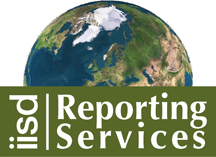News * Abou us * the ENB team * DONATE * Activities * Search * IISD RS home * IISD.org * RSS * What is RSS? * Links |
|
MEA Bulletin
24 June 2006 Options for harmonizing national reporting to biodiversity-related agreements
By Peter Herkenrath, UNEP World Conservation
Monitoring Centre IntroductionMost multilateral environmental agreements require Parties to report at regular intervals on the measures they have taken to implement the agreement. National reporting serves a number of purposes: it demonstrates Parties’ compliance with the provisions of the agreement, allows for an overview of the status and effectiveness of implementation, supports the identification of future priorities, enables decision-making, and facilitates the identification of interactions with other processes. In recent years, there has been a growing recognition that the reporting burden has increased. As governments accede to more agreements, they are confronted with a multitude of reports to prepare. The reporting formats are often complex and many questions are similar to those in reporting formats of other conventions. This latter challenge easily leads to duplication of work between the national focal points of different conventions. Reporting constitutes a challenge for institutional linkages of national focal points as well as the underlying national biodiversity information. The UNEP/UNEP-WCMC harmonization of reporting projectIn 1998, the United Nations Environment Programme (UNEP), in collaboration with the secretariats of the global biodiversity-related conventions, commissioned the UNEP World Conservation Monitoring Centre to prepare a Feasibility Study for a Harmonized Information Management Infrastructure for Biodiversity-related Treaties, covering the Convention on Biological Diversity (CBD), Convention on International Trade in Endangered Species (CITES), Convention on Migratory Species (CMS), Ramsar Convention on Wetlands and World Heritage Convention. A follow-up workshop in Cambridge, UK, in 2000 resulted in four pilot studies on harmonization of national reporting in Ghana, Indonesia, Panama and the Seychelles. The results of the pilot projects were discussed with agreement secretariats, interested Parties and organisations at a workshop in 2004 in Belgium, convened by UNEP-WCMC and supported by the governments of Belgium, the UK and Germany. The workshop resulted in a number of recommendations that were made available to the governing bodies of the biodiversity-related conventions. Subsequently, through decisions of their Conferences of the Parties, CBD, CITES, CMS and Ramsar have provided mandates for carrying out further work on harmonization of reporting. Obstacles and opportunities Harmonization of reporting faces several obstacles. The reporting cycles differ between the conventions. Some conventions require very specific information in a specific format that is hardly compatible with other conventions. At the national level, the involvement of different ministries often makes harmonization efforts difficult. However, the modular approach to managing the information required by reporting has proven a useful way forward. National agencies responsible for, for example, agriculture, forestry and water would regularly produce information modules and make them available in a biodiversity database of some kind. This information could be updated periodically. When the focal points prepare their national reports, they could draw on the information already provided. This approach could be supported by regional cooperation, facilitated by intergovernmental bodies. At the global level, the conventions could develop joint report questions on issues of common interest, such as inland waters, protected areas or indicators. Key elements of future reporting There are other issues that need to be addressed to help reporting achieve its purposes. Increasingly, governing bodies of conventions call for better information for assessing the outcome of implementation activities. So far, national reporting has tended to focus on processes – on activities Parties have undertaken to fulfill their obligations under agreements. To measure progress, for example towards the 2010 biodiversity target, information on the status and trends of biodiversity is urgently needed, information that needs to come from the national level. This need is increasingly being recognized by the more recent reporting formats. Another issue is on-line reporting by Parties. The Memorandum of Understanding on the Conservation and Management of Marine Turtles and their Habitats of the Indian Ocean and South-East Asia has introduced on-line reporting, and it is currently being discussed within the CMS and the CMS agreements. On-line reporting allows for continuous updating, enables users to view and query national reports, and allows Parties and conventions to easily generate up-to-date reports. At the national level, future reporting would benefit from a number of elements. Firstly, the information that is needed for national implementation of agreements needs to be identified. Secondly, it should be determined how this information can best be managed, for example through a national biodiversity database, and the identification of thematic information modules required for reporting. Thirdly, institutional arrangements need to be made, including liaison between the information managers and the convention focal points. Harmonizing biodiversity information management and national reporting requires additional efforts in the short-term. In the long-term, however, it is expected to lead to substantial benefits from avoiding duplication of efforts and providing synergies. |

